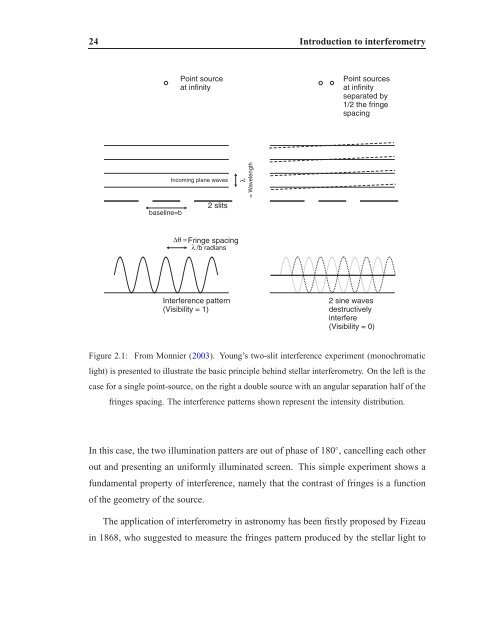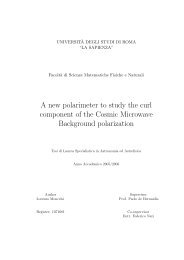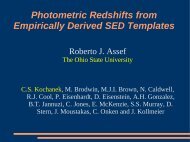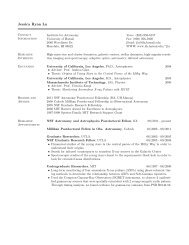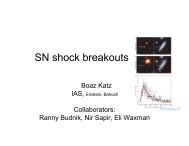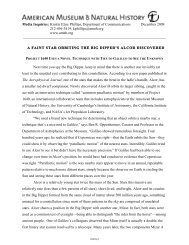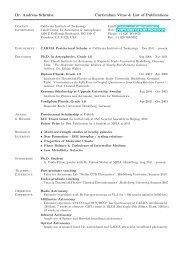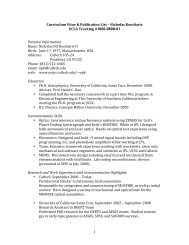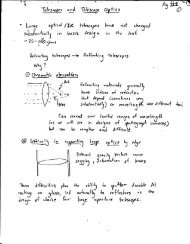- Page 1: Università degli Studi di Milano F
- Page 5 and 6: CONTENTS I Introduction 1 1 Scienti
- Page 7 and 8: CONTENTS v 4.5 Comparison with prev
- Page 9: Part I Introduction
- Page 12 and 13: 4 Scientific overview the critical
- Page 14 and 15: 6 Scientific overview Log νFν Log
- Page 16 and 17: 8 Scientific overview are the subje
- Page 18 and 19: 10 Scientific overview disk regions
- Page 20 and 21: 12 Scientific overview Figure 1.2:
- Page 22 and 23: 14 Scientific overview depleted inn
- Page 24 and 25: 16 Scientific overview the gas and
- Page 26 and 27: 18 Scientific overview Figure 1.3:
- Page 28 and 29: 20 Scientific overview We propose a
- Page 31: CHAPTER 2 2.1 A bit of history Intr
- Page 35 and 36: 2.2 Basic principle of astronomical
- Page 37 and 38: 2.3 Optical versus millimeter inter
- Page 39 and 40: 2.3 Optical versus millimeter inter
- Page 41 and 42: 2.3 Optical versus millimeter inter
- Page 43 and 44: 2.4 Introduction to modelling techn
- Page 45: 2.4 Introduction to modelling techn
- Page 49 and 50: CHAPTER 3 The shape of the inner ri
- Page 51 and 52: 3.1 Introduction 43 Tauri stars (Ei
- Page 53 and 54: 3.2 Model description 45 adapt the
- Page 55 and 56: 3.2 Model description 47 log(δR/R
- Page 57 and 58: 3.2 Model description 49 the pressu
- Page 59 and 60: 3.3 Results 51 Photospherical heigh
- Page 61 and 62: 3.3 Results 53 ever, is sufficientl
- Page 63 and 64: 3.3 Results 55 Sec. 3.3.1 (see Fig.
- Page 65 and 66: 3.4 Discussion 57 the value ofǫ, t
- Page 67 and 68: 3.4 Discussion 59 sample of Fig. 3.
- Page 69 and 70: 3.5 Summary and conclusions 61 R in
- Page 71 and 72: 3.6 Appendix 63 However, the bright
- Page 73: 3.6 Appendix 65 Figure 3.9: Left pa
- Page 76 and 77: 68 Large dust grains in the inner r
- Page 78 and 79: 70 Large dust grains in the inner r
- Page 80 and 81: 72 Large dust grains in the inner r
- Page 82 and 83:
74 Large dust grains in the inner r
- Page 84 and 85:
76 Large dust grains in the inner r
- Page 86 and 87:
78 Large dust grains in the inner r
- Page 88 and 89:
80 Large dust grains in the inner r
- Page 90 and 91:
82 Large dust grains in the inner r
- Page 92 and 93:
84 Large dust grains in the inner r
- Page 94 and 95:
86 Large dust grains in the inner r
- Page 96 and 97:
Face-on disk image Baseline (m) V 2
- Page 98 and 99:
V 2 1 0.8 0.6 0.4 0.2 0 0 50 100 15
- Page 100 and 101:
V 2 1 0.8 0.6 0.4 0.2 0 0 50 100 15
- Page 103 and 104:
CHAPTER 5 More on the “puffed-up
- Page 105 and 106:
5.1 Fuzzy and sharp rims 97 opacity
- Page 107 and 108:
5.2 New shapes for the rim 99 grain
- Page 109 and 110:
5.3 New observational results 101 (
- Page 111:
5.3 New observational results 103 w
- Page 115 and 116:
CHAPTER 6 Constraining the wind lau
- Page 117 and 118:
6.1 Introduction 109 λ Fλ (erg cm
- Page 119 and 120:
6.2 Observations and data reduction
- Page 121 and 122:
6.3 Results and discussions 113 V V
- Page 123 and 124:
6.4 Conclusions 115 note however th
- Page 125:
Part IV The structure of the outer
- Page 128 and 129:
120 The keplerian disk of HD 163296
- Page 130 and 131:
122 The keplerian disk of HD 163296
- Page 132 and 133:
124 The keplerian disk of HD 163296
- Page 134 and 135:
126 The keplerian disk of HD 163296
- Page 136 and 137:
128 The keplerian disk of HD 163296
- Page 138 and 139:
130 The keplerian disk of HD 163296
- Page 140 and 141:
132 The keplerian disk of HD 163296
- Page 142 and 143:
134 The keplerian disk of HD 163296
- Page 144 and 145:
136 The keplerian disk of HD 163296
- Page 146 and 147:
138 The keplerian disk of HD 163296
- Page 148 and 149:
140 The keplerian disk of HD 163296
- Page 150 and 151:
142 The keplerian disk of HD 163296
- Page 152 and 153:
144 The keplerian disk of HD 163296
- Page 154 and 155:
146 The keplerian disk of HD 163296
- Page 157:
Part V Conclusions and future prosp
- Page 160 and 161:
152 Summary and Conclusions ∼1 an
- Page 162 and 163:
154 Summary and Conclusions disk in
- Page 165 and 166:
CHAPTER 9 Future developments As my
- Page 167 and 168:
9.1 Gas in the inner disk of Herbig
- Page 169 and 170:
9.2 Probing planet formation throug
- Page 171 and 172:
9.2 Probing planet formation throug
- Page 173 and 174:
9.2 Probing planet formation throug
- Page 175 and 176:
9.2 Probing planet formation throug
- Page 177:
Published papers • Isella, A.; Te
- Page 180 and 181:
172 BIBLIOGRAPHY [2000] Bodenheimer
- Page 182 and 183:
174 BIBLIOGRAPHY [2004] Gail H.-P.,
- Page 184 and 185:
176 BIBLIOGRAPHY Arizona Press, Tuc
- Page 186 and 187:
178 BIBLIOGRAPHY [2001] Thompson A.


